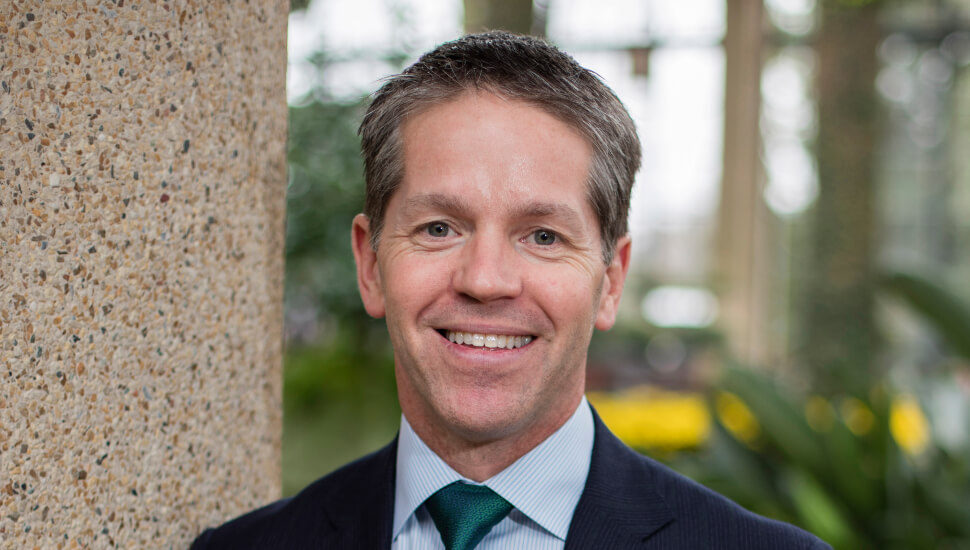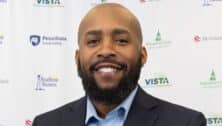Chester County Leadership: Paul Redman – President and CEO of Longwood Gardens


Paul Redman, the President and CEO of Longwood Gardens, spoke with VISTA Today about being born in Texas and growing up as the son of a cowboy in Oklahoma; his affinity for music and playing the violin at a high level, thanks to his public high school’s world-class performing arts program; his struggles as a student at Oklahoma State; and the genesis of his passion for botany and horticulture.
Redman also discussed how he landed at Longwood Gardens — where a dear friend once told him that “if God had as much money as the du Ponts, heaven would look like Longwood Gardens” — at a time when there was a lot of chatter about its need for change. Furthermore, he talked about the challenge of implementing that change within an institution that has its identity grounded in the legacy of one individual and a family; his 15-year tenure there; and what the future holds for the world-renowned tourist attraction.
Where were you born, and where did you grow up, Paul?
I was born the second of two children in Bowie, Texas. I was the first baby born in the new Bowie Hospital on May 7, 1966. My family moved to southeastern Oklahoma, and I grew up in McAlester, Oklahoma.
What did your parents do?
My father was a cowboy – a tried and true cowboy who roped cattle and all. I grew up on a horse and cattle ranch. He was a physical therapist assistant later in life. He went back to college in his mid-40s to study physical therapy and made the switch. My mom was a paralegal.
At one point, my dad was a stay-at-home dad taking care of his mom, who was living with us. She had Alzheimer’s, so he took care of her full time while my mom was working. That was in the early 1980s and not common. He realized he wanted to make a career switch and went back to school to become a PTA.
What memories do you have growing up in McAlester?
There are so many. The first, I would say, is the people. The town I grew up in had around 20,000 people. It was a large enough community that you didn’t know everybody, but you could quickly find out something about someone. It was a friendly community. That saying about “it takes a village” is true about McAlester. In my high school, the church we went to, the community, there was much care and mentorship.
I had so many opportunities that were afforded to me because of that. There was an interest in wanting to make sure I was given every chance that I could have and support to succeed in life. You don’t find that everywhere.
Was your experience in McAlester unique?
I would say it was about the community, but at the same time, I worked very hard. My family was not wealthy, and so if I wanted anything, I had to get a job and work.
What kind of jobs did you have?
I started mowing my neighbor’s lawns in fifth grade and throughout middle school to make money on the side. In my sophomore year of high school, I had a job in a local, family-owned department store called Hunt’s. I worked as the elevator boy and custodian. The store had an old fashion elevator with a cage. You had to manually stop on the mezzanine, the second floor, and the third floor.
You got to meet a lot of people doing that job.
I did, and I spent a lot of time in that elevator. When the owner, Mr. Davis, came in, I would be so scared that I would not be able to hit the landing on the mezzanine where his office was perfectly.
What lessons did you learn in that job that stay with you today?
I learned a great deal about service and skills you need in life – showing up to work on time, if you perform well, you’re rewarded.
After a year, I moved to the men’s floor, where I was a salesman. In that job, I learned customer service and work ethic. On a particularly slow day, the owner’s son came up to me and said, “Paul, you can fold the shirts,” and I told him I had already done that, to which he told me to “fold them again.” There was always something to do. I couldn’t just don’t sit around and do nothing.
Did it teach you a sense of fashion?
It was a tremendous help that way because I had to look nice. I had to be wearing the clothes we were selling. And now I know how to mark trousers for alterations.
Did you play any sports in high school?
Not officially. I have always been a lifelong fitness person. I loved playing tennis. I’ve been an off-and-on runner and jogger for years. Swimming has always been a consistent part of my life as well. Growing up on a horse and cattle ranch is a lot of hard work. You had to be up early every day to feed the cattle and the horses.
Not unlike Longwood.
Longwood Gardens is dynamic. You never know what to expect. Things are changing and evolving all the time. You’re right; most of the jobs I’ve had have not been about widget making. It’s been about the dynamics of it all. Being a horticulturist first and foremost and working with plants, that’s the ultimate because it’s something you cannot control at the end of the day. You can do your very best to make it the best you can.
What kind of music were you listening to back then?
I love music. I grew up in a house of music. My father’s mother was a Kindergarten school teacher and a wonderful piano player. My mother and her mother were both piano players, so I learned to play the piano early on.
I was fortunate to grow up in a town with a very progressive and professional performing arts program funded by local business leaders. You were introduced to instruments very early in school. I started to play the violin in 6th grade and continued to play in the high school orchestra.
I went to intensive summer camps and competed in competitions. I trained with professionals and thought about making it into a career before I realized that kind of work is particularly difficult and would require having multiple side jobs to survive.
The violin is not an instrument a typical high schooler picks up.
It was such an unusual experience. This public school system in McAlester, OK had a world-class performing arts program. It produced some incredible talent out there in the world. I saw some program graduates who had made their profession, and that’s when I realized that career path was not for me. One of the benefits was when I went off to college at Oklahoma State University, I was able to walk on to the University’s symphony. They put me in the back of the violin section, and I loved it because I could play for fun rather than a career.
Why Oklahoma State?
I was an OK student in high school. There were some programs that I was in that were accelerated – specifically in science and business. By the time I finished high school, I had already mastered two years of accounting and many science and biology classes. I always thought of myself as a Texan, especially because I was born there and my family had their roots there, so I wanted to go to the University of Texas. My parents said absolutely not to that one and told me to go to an in-state school. I went to Oklahoma State because that’s where my friends went.
Looking back, was Oklahoma State a good choice?
Absolutely. It was transformative. As I was saying, I had a great education in high school, but it was a public school in a small town. When I got to college, I wasn’t prepared. I had friends who went to very progressive, well-funded public schools in other parts of the state, and they had that college preparatory work that I did not have.
The first three years of college were a struggle for me. A large part of that was maturity. What would have been my senior year at Oklahoma State, I dropped out and moved home. My parents told me that if I was coming home, I would work and pay for rent and groceries. I went back to college a year later, and my time at home was a very motivating experience. I then studied more, matured, focused, and made the honor roles.
When did you find a love of botany and horticulture?
Gardening, plants, and flowers were always a part of my life. My dad’s mom had a garden, and I was always working there with her. When I went to college, I studied finance and accounting and hated it. I did career counseling and the top two careers out of the thousand that popped out were horticulture and landscape architecture. I looked at the counselor and said, “what’s that?”
The counselor introduced me to professors in both the horticulture and landscaping architecture programs, which were under one department in the college, and I began the program. Going back to the theme of “it takes a village,” the professors in that department were phenomenal. It was a relatively small department, so I really got to know the faculty.
Who were the people who saw potential in you and opened doors for you, Paul?
The list is too long! One professor at Oklahoma State in particular, Paul Mitchell, was my undergrad advisor in the horticulture program. He was the one who said I should explore a career working in a public garden. I asked him what that was, and he handed me an internship directory and told me to look it over to see if any opportunities were of interest to me. I picked the most glamorous locations that paid the most and applied.
I applied for an internship at the National Tropical Botanical Garden on the island of Kauai in Hawaii. It was a competitive program; they only took six interns for the summer session, but I was accepted. I had never flown that far before, so that part of the experience was very meaningful for me and really the turning point.
Who else?
My internship at the National Tropical Botanical Garden led to a job. After that summer, I went back to Oklahoma to finish undergrad, and I was asked to come back for a full-time position. I was in my early to mid-20s and serving as the volunteer coordinator for the Garden, working with retired executives, university leaders, and academics. I was charged with facilitating their activities, education, learning, and engagement. They took a direct interest in me, and I learned from them.
What do you think they saw in you?
Authenticity. I like to think I have strong values, and I am respectful. Ultimately, my job was to engage and motivate these individuals. That meant that they had to enjoy it too. It had to be fun, and they had to find the benefit in it as well. I learned from them how to do that.
Anyone else?
There are two points I would say. Graduate school was critical. I left Hawaii to go back to graduate school at Oklahoma State. Graduate school experience taught me critical thinking and communication. Before coming to Longwood, I was in Columbus, Ohio. At 28 years old, I was the director of horticulture at the Franklin Park Conservatory. The garden didn’t have any money, and no one wanted anything to do with us. I was told “no” so many times. It was the opposite of Longwood.
While I was the Executive Director there, I was persistent and just continued to make the case for the garden. After a while, people started saying “yes”. Large company CEOs and leaders of the community took an interest in me and the garden and wanted it to be a thriving, healthy, successful part of the community. To have that kind of access to important leaders in the community, you wouldn’t get that in every community at that young age. That mentorship in Columbus was critical. I wouldn’t be here today at Longwood were it not for my experience in Columbus.
How did you land at Longwood?
A headhunter contacted me. The first time they called, I said no. At the time, my dreams for the garden in Columbus were coming true. The relationships that I just spent years building and cultivating were starting to pay off. Walking away from those relationships was a very big deal.
My husband, Dean, and I also loved our life in Columbus. Moving here was a risk on many levels. Longwood called me back on the right day, and I said yes.
The process for interviewing for the job was thorough and in-depth on both sides – on Longwood and by me. There was a tremendous amount of risk on my part because everything was succeeding in Columbus, and there was a lot of chatter about the need for change at Longwood.
Getting the job was amazing, and I love Longwood, but those early days were an experiment that I wasn’t sure was going to work.
Was Longwood what you expected?
At the time, on the surface Longwood was successful and thriving. It had a great reputation. Underneath it all, there were things that needed to be fixed or polished. That can be difficult and challenging, especially with an institution like Longwood, whose identity is grounded in the legacy of one individual and a family. When both are intrinsically tied to that institution as well, facilitating change can be a challenge.
You’ve been here 15 years, what are the priorities, opportunities, and challenges that you’re focused on?
The pandemic was extremely painful for all of us, and painful at Longwood in particular, but we did have some good outcomes. One is that we have built an incredible family and culture at Longwood. The true values and the character came out.
Prior to the pandemic, we all worked very hard, but we were doing it differently. Once the shutdown happened, there was a new level of empathy, understanding, and cooperation within. We had no guests, so we were all working together. We kept our full-time employees on the payroll. There was a lot of cross-pollination and a new understanding of roles for everybody. One day you were a security guard and the other, you were gardening.
There was real power and energy that came from that, and we were given a much deeper appreciation for one another and our roles here at Longwood. For me now, as a leader, I am looking at how can I continue this. How can I care more for my staff, my volunteers, and this team here? If you can harness that power, we are unstoppable as a family.
Where are you taking that harnessed power?
We have a lot of Type-A personalities here. We are a very talented, highly creative group of people. Excellence is in their DNA. I didn’t create that; it was here when I got here. We have individuals who want something better and always working toward that.
Talk to me about the reimaging process. Where does that fit in?
It’s all part of the continued “reimagining of Longwood.” I almost hate to use that word because while we are creating new experiences, those experiences are built upon the things everyone has always loved and known us for. We do not think in short-term solutions here.
Everything that we’ve done, from the Meadow Garden to the Main Fountain Garden to now “Longwood ReImagined,” it’s about future-proofing Longwood. We are thinking about 100 years and beyond.
I may not ever really see the true outcome and impact of Longwood Reimaged during my tenure here. It’s about the tool that we are providing and the opportunity that is being provided to the next generation of people who will be leading and caring for Longwood. Who knows what they will do with it; they may take our idea today to a higher level.
There’s something very magical about Longwood for people. We like to say it’s a world apart. People are attracted to Longwood because when they walk through our gates, they are transported. All the stuff happening in the outside world, they can come here and forget about life for a short time. They can be with themselves, their families, and their friends here.
What do you do with your free time?
My husband Dean and I purchased a 180-year-old home in Birmingham Township in 2019. We lived on the property at Longwood for 15 years prior. We spent the better parts of 2019 and 2020 restoring it. Dean is an architect, and you know how old homes go, there is always work to be done. I keep saying to him, “you know, we can pay someone to do this!” I spent this past summer restoring the shutters that included restoring the original hardware, stripping 180-years of paint and then painting them.
Do you read?
I read every night, but I don’t get very far because I’m usually so tired. I read a few pages at a time, so it usually takes me a while to finish a book. When we go away on vacation, I’m able to read more.
Right now, I’m reading Doris Kearns Goodwin “The Homefront.” I like history books, especially when it’s about leadership. This particular book is an interesting point of view of what was happening in the United States during WWII with FDR and Mrs. Roosevelt. There are some great life lessons, and while you’re reading about that time period you can’t help but think not a lot has changed with many issues.
What gives you hope, Paul?
That’s easy. The next generation of talent. We have so many students that come through Longwood, and we have the opportunity to get to know them. The way they think about the world today is so different and inspiring. Because of that, I know Longwood is going to be OK.
What’s the best piece of advice you’ve ever received, Paul?
When I was finishing my undergrad, I had two job opportunities. The one in Hawaii and one in Dallas working for a large landscape company. I called my mother in 1989 to ask her thoughts, and she said, “the way I look at it, you’re going to be poor no matter where you live. If I were you, I know where I’d want to live.”
It was simple but profound advice. It was about happiness. Go someplace different. Be someplace where you’re going to be happy and have a new experience. That advice about “do something because you love it and you’ll be happy” is so simple, yet so hard for some people.
__________
Publisher’s note: Laura Manion contributed to this profile.
Connect With Your Community
Subscribe to stay informed!
"*" indicates required fields












































![95000-1023_ACJ_BannerAd[1]](https://vista.today/wp-content/uploads/2023/03/95000-1023_ACJ_BannerAd1.jpg)



